A Comparative Report: Healthcare Systems in the USA, UK, and Australia
VerifiedAdded on 2020/03/04
|13
|2258
|309
Report
AI Summary
This report provides a comparative analysis of the healthcare systems in the United States, the United Kingdom, and Australia. The introduction highlights the importance of healthcare advancements in gauging a country's progress and sets the objective to scrutinize the cost, accessibility, choice, and quality of each country's healthcare system. The report delves into detailed discussions of each country's system, examining their respective costs, access, choice, and quality of care, supported by statistical data, figures, and tables. The Australian system is highlighted, focusing on its mixed approach of governmental control and privatization, and its Medicare system. The UK's NHS system, with its emphasis on accessibility, and the US's private sector-dominated system are also examined. The report concludes with a comparative analysis, summarizing the advantages and disadvantages of each system and identifies potential areas for improvement, especially within the Australian system, and offers recommendations for enhancements in each country's approach to healthcare delivery.
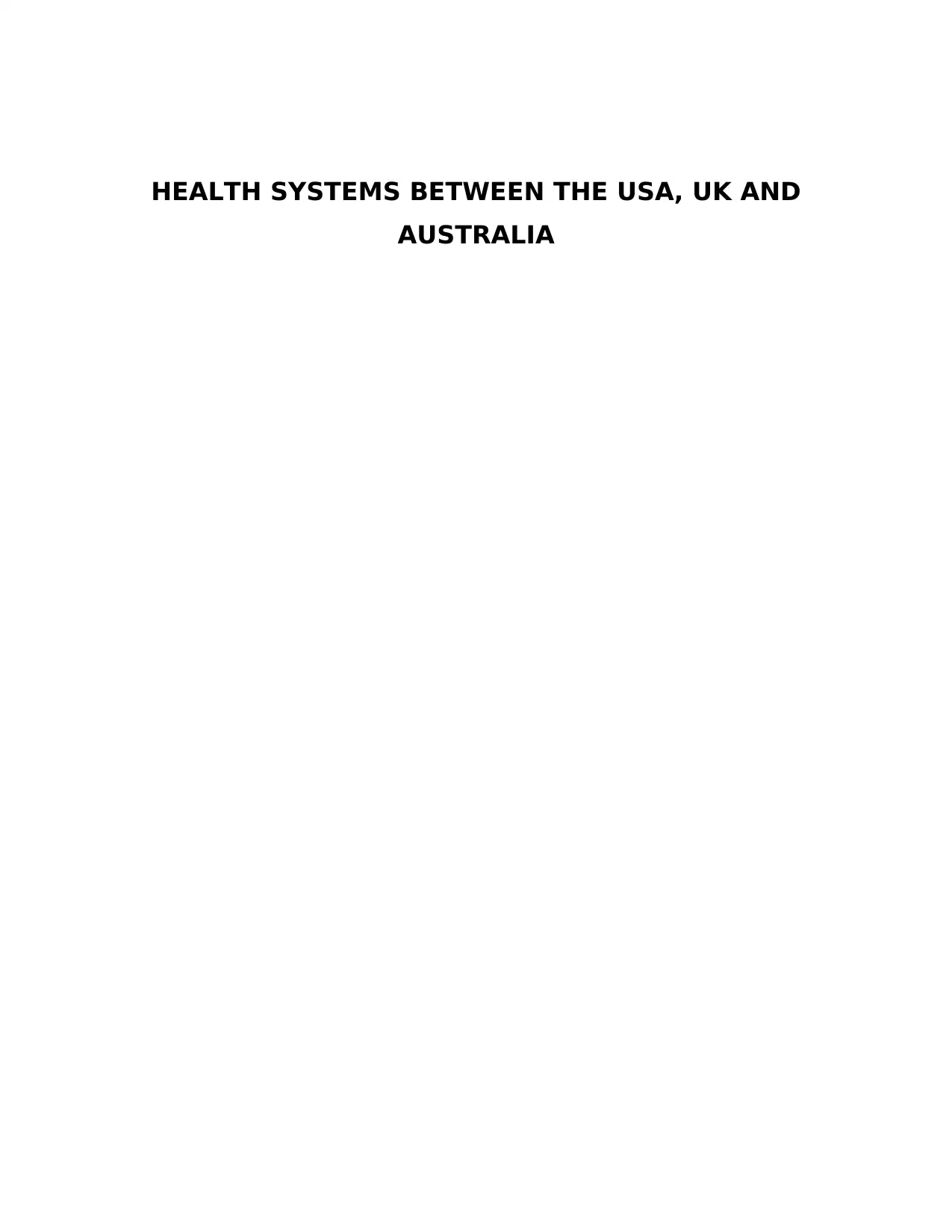
HEALTH SYSTEMS BETWEEN THE USA, UK AND
AUSTRALIA
AUSTRALIA
Paraphrase This Document
Need a fresh take? Get an instant paraphrase of this document with our AI Paraphraser
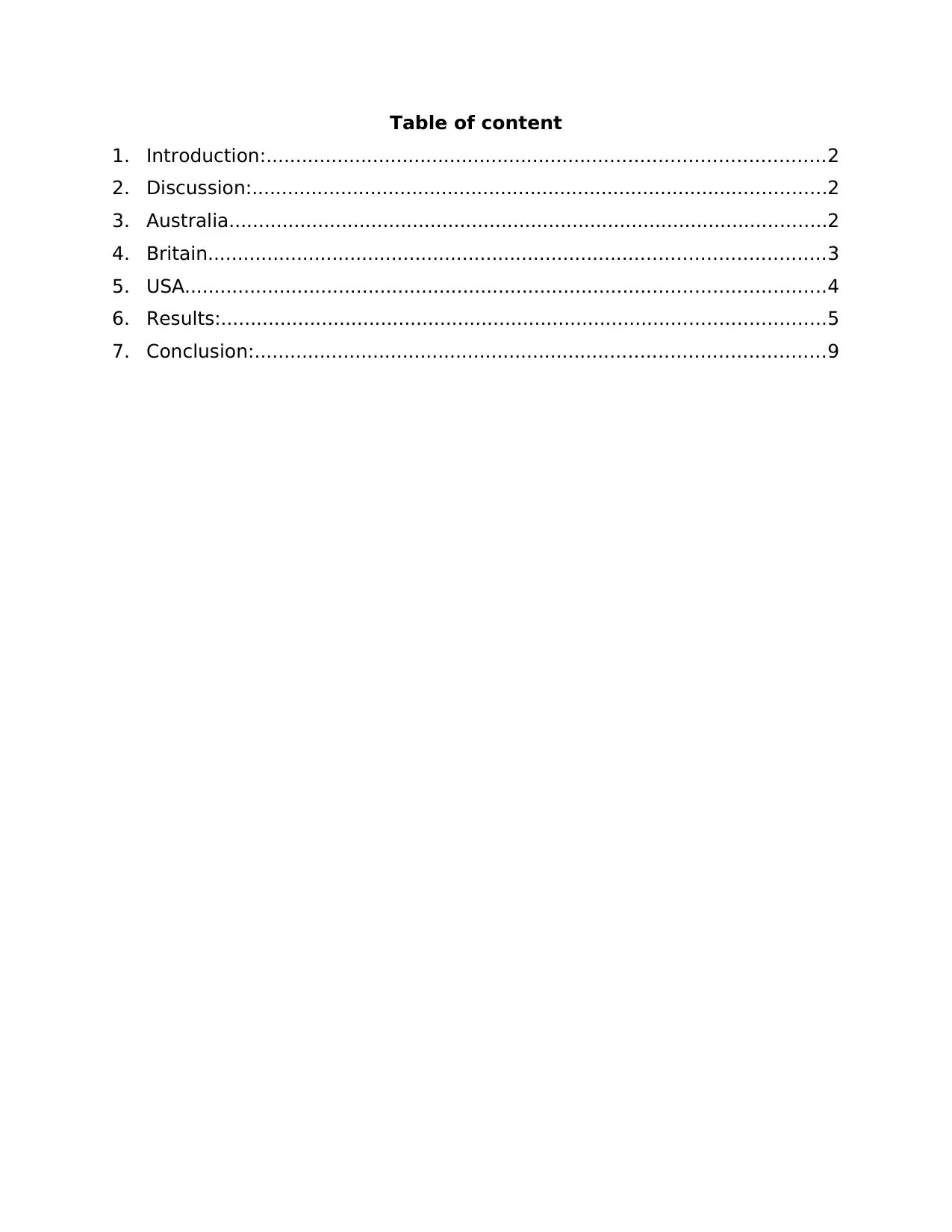
Table of content
1. Introduction:..............................................................................................2
2. Discussion:.................................................................................................2
3. Australia.....................................................................................................2
4. Britain........................................................................................................3
5. USA............................................................................................................4
6. Results:......................................................................................................5
7. Conclusion:................................................................................................9
1. Introduction:..............................................................................................2
2. Discussion:.................................................................................................2
3. Australia.....................................................................................................2
4. Britain........................................................................................................3
5. USA............................................................................................................4
6. Results:......................................................................................................5
7. Conclusion:................................................................................................9
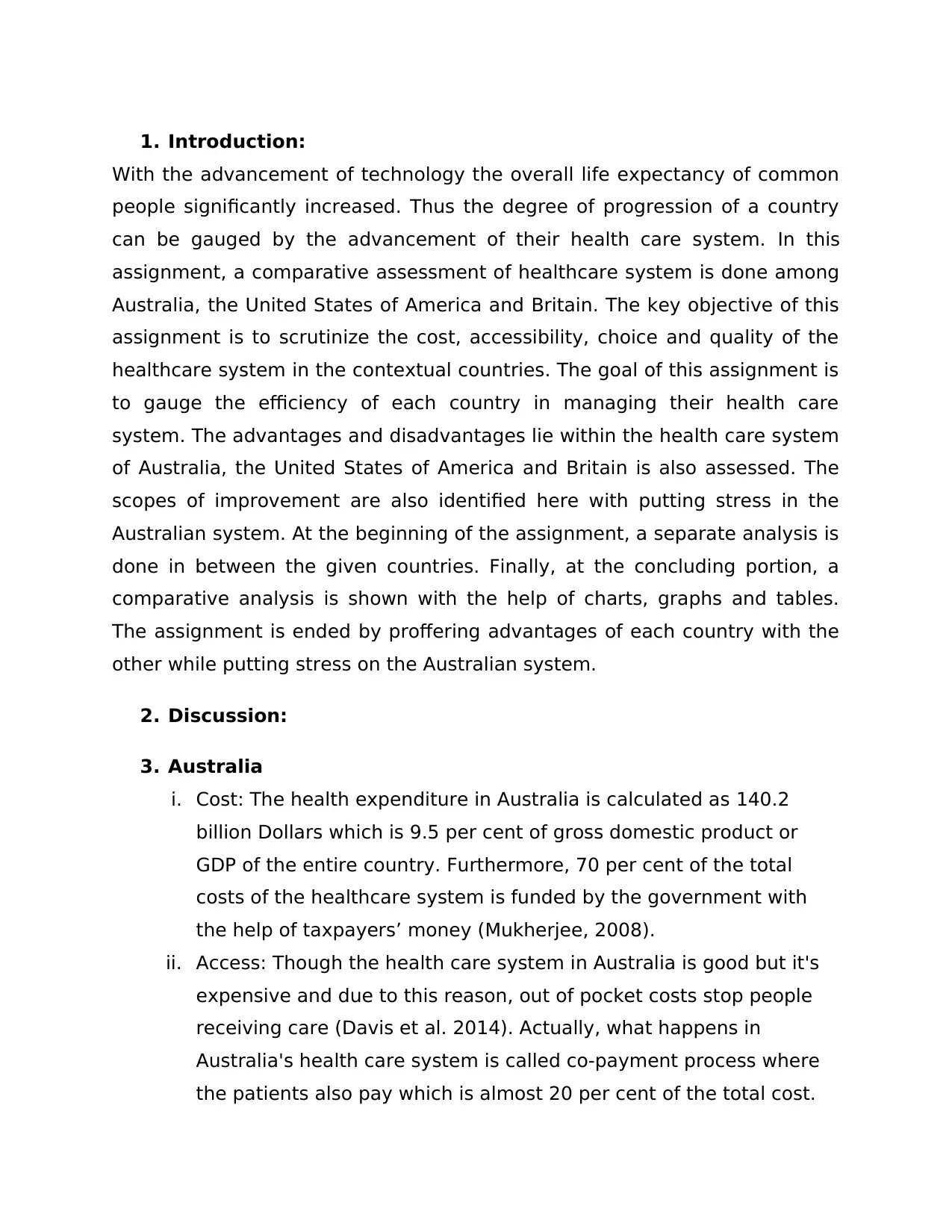
1. Introduction:
With the advancement of technology the overall life expectancy of common
people significantly increased. Thus the degree of progression of a country
can be gauged by the advancement of their health care system. In this
assignment, a comparative assessment of healthcare system is done among
Australia, the United States of America and Britain. The key objective of this
assignment is to scrutinize the cost, accessibility, choice and quality of the
healthcare system in the contextual countries. The goal of this assignment is
to gauge the efficiency of each country in managing their health care
system. The advantages and disadvantages lie within the health care system
of Australia, the United States of America and Britain is also assessed. The
scopes of improvement are also identified here with putting stress in the
Australian system. At the beginning of the assignment, a separate analysis is
done in between the given countries. Finally, at the concluding portion, a
comparative analysis is shown with the help of charts, graphs and tables.
The assignment is ended by proffering advantages of each country with the
other while putting stress on the Australian system.
2. Discussion:
3. Australia
i. Cost: The health expenditure in Australia is calculated as 140.2
billion Dollars which is 9.5 per cent of gross domestic product or
GDP of the entire country. Furthermore, 70 per cent of the total
costs of the healthcare system is funded by the government with
the help of taxpayers’ money (Mukherjee, 2008).
ii. Access: Though the health care system in Australia is good but it's
expensive and due to this reason, out of pocket costs stop people
receiving care (Davis et al. 2014). Actually, what happens in
Australia's health care system is called co-payment process where
the patients also pay which is almost 20 per cent of the total cost.
With the advancement of technology the overall life expectancy of common
people significantly increased. Thus the degree of progression of a country
can be gauged by the advancement of their health care system. In this
assignment, a comparative assessment of healthcare system is done among
Australia, the United States of America and Britain. The key objective of this
assignment is to scrutinize the cost, accessibility, choice and quality of the
healthcare system in the contextual countries. The goal of this assignment is
to gauge the efficiency of each country in managing their health care
system. The advantages and disadvantages lie within the health care system
of Australia, the United States of America and Britain is also assessed. The
scopes of improvement are also identified here with putting stress in the
Australian system. At the beginning of the assignment, a separate analysis is
done in between the given countries. Finally, at the concluding portion, a
comparative analysis is shown with the help of charts, graphs and tables.
The assignment is ended by proffering advantages of each country with the
other while putting stress on the Australian system.
2. Discussion:
3. Australia
i. Cost: The health expenditure in Australia is calculated as 140.2
billion Dollars which is 9.5 per cent of gross domestic product or
GDP of the entire country. Furthermore, 70 per cent of the total
costs of the healthcare system is funded by the government with
the help of taxpayers’ money (Mukherjee, 2008).
ii. Access: Though the health care system in Australia is good but it's
expensive and due to this reason, out of pocket costs stop people
receiving care (Davis et al. 2014). Actually, what happens in
Australia's health care system is called co-payment process where
the patients also pay which is almost 20 per cent of the total cost.
⊘ This is a preview!⊘
Do you want full access?
Subscribe today to unlock all pages.

Trusted by 1+ million students worldwide
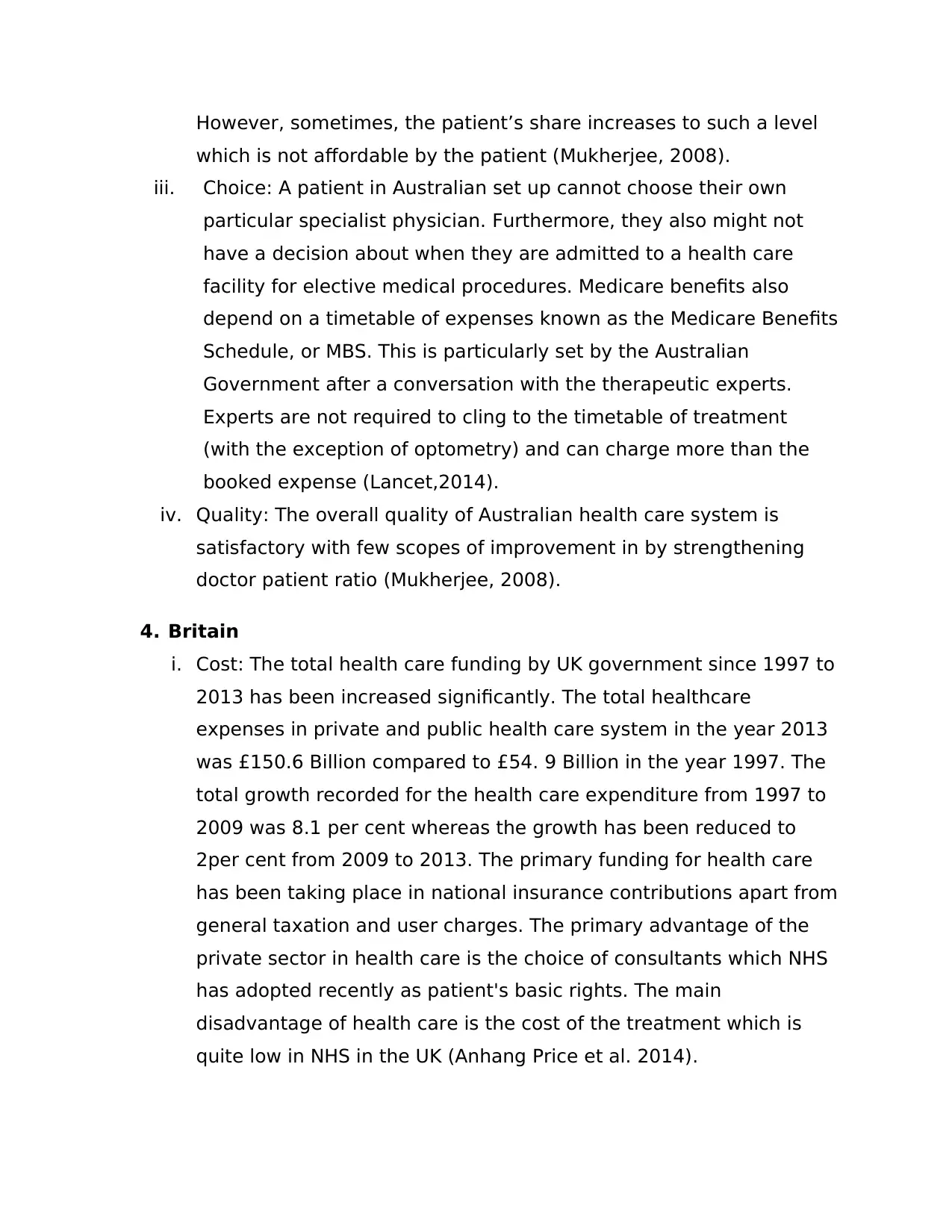
However, sometimes, the patient’s share increases to such a level
which is not affordable by the patient (Mukherjee, 2008).
iii. Choice: A patient in Australian set up cannot choose their own
particular specialist physician. Furthermore, they also might not
have a decision about when they are admitted to a health care
facility for elective medical procedures. Medicare benefits also
depend on a timetable of expenses known as the Medicare Benefits
Schedule, or MBS. This is particularly set by the Australian
Government after a conversation with the therapeutic experts.
Experts are not required to cling to the timetable of treatment
(with the exception of optometry) and can charge more than the
booked expense (Lancet,2014).
iv. Quality: The overall quality of Australian health care system is
satisfactory with few scopes of improvement in by strengthening
doctor patient ratio (Mukherjee, 2008).
4. Britain
i. Cost: The total health care funding by UK government since 1997 to
2013 has been increased significantly. The total healthcare
expenses in private and public health care system in the year 2013
was £150.6 Billion compared to £54. 9 Billion in the year 1997. The
total growth recorded for the health care expenditure from 1997 to
2009 was 8.1 per cent whereas the growth has been reduced to
2per cent from 2009 to 2013. The primary funding for health care
has been taking place in national insurance contributions apart from
general taxation and user charges. The primary advantage of the
private sector in health care is the choice of consultants which NHS
has adopted recently as patient's basic rights. The main
disadvantage of health care is the cost of the treatment which is
quite low in NHS in the UK (Anhang Price et al. 2014).
which is not affordable by the patient (Mukherjee, 2008).
iii. Choice: A patient in Australian set up cannot choose their own
particular specialist physician. Furthermore, they also might not
have a decision about when they are admitted to a health care
facility for elective medical procedures. Medicare benefits also
depend on a timetable of expenses known as the Medicare Benefits
Schedule, or MBS. This is particularly set by the Australian
Government after a conversation with the therapeutic experts.
Experts are not required to cling to the timetable of treatment
(with the exception of optometry) and can charge more than the
booked expense (Lancet,2014).
iv. Quality: The overall quality of Australian health care system is
satisfactory with few scopes of improvement in by strengthening
doctor patient ratio (Mukherjee, 2008).
4. Britain
i. Cost: The total health care funding by UK government since 1997 to
2013 has been increased significantly. The total healthcare
expenses in private and public health care system in the year 2013
was £150.6 Billion compared to £54. 9 Billion in the year 1997. The
total growth recorded for the health care expenditure from 1997 to
2009 was 8.1 per cent whereas the growth has been reduced to
2per cent from 2009 to 2013. The primary funding for health care
has been taking place in national insurance contributions apart from
general taxation and user charges. The primary advantage of the
private sector in health care is the choice of consultants which NHS
has adopted recently as patient's basic rights. The main
disadvantage of health care is the cost of the treatment which is
quite low in NHS in the UK (Anhang Price et al. 2014).
Paraphrase This Document
Need a fresh take? Get an instant paraphrase of this document with our AI Paraphraser

ii. Access: national health care system in the UK has been the most
accessible health care system in terms of cost. The funding has
been increased significantly in the NHS which provides more
choices for the low cost and high quality treatment. Whereas the in
the accessibility in the private sector dependent on the affordability
and wealth. The choice of specialist was always available in private
sector which NHS has been implementing as the basic right of the
patients. The cost involved in both the cases poses a huge
difference where high cost treatment offered by public sector
compared to NHS scheme (Mukherjee, 2008).
iii. Choice: the people covered under NHS have been provided with
some effective rights for choices such as general surgery and NHS
care. Even the patients under NHS can choose the organization
covered under NHS according to their convenience but the choice in
private section depends upon the cost affordability and wealth.
iv. Quality: the quality concerns of NHS have been resolved by the
periodic increase in budget allocation from 1997 to 2013. The
primary concern of the NHS constitution is to provide maximized
value with less cost (Fleming, 2008).
5. USA
i. Cost: the national expenditure of United States on Health care has
been increased to $3.2 trillion which is a significant increase by 5.8
per cent. The affordable care act has a significant impact on the
health care system in the USA which increases the public health
care funding. Therefore total growth including private and public
sector has significantly increased in late 2015. The government
coverage for health care services in the United States is 27.8 per
cent whereas the primary funding took place from 84per cent
insurance coverage for health care system in the United States. The
advantage of private health care system in the USA is fast
accessible health care system in terms of cost. The funding has
been increased significantly in the NHS which provides more
choices for the low cost and high quality treatment. Whereas the in
the accessibility in the private sector dependent on the affordability
and wealth. The choice of specialist was always available in private
sector which NHS has been implementing as the basic right of the
patients. The cost involved in both the cases poses a huge
difference where high cost treatment offered by public sector
compared to NHS scheme (Mukherjee, 2008).
iii. Choice: the people covered under NHS have been provided with
some effective rights for choices such as general surgery and NHS
care. Even the patients under NHS can choose the organization
covered under NHS according to their convenience but the choice in
private section depends upon the cost affordability and wealth.
iv. Quality: the quality concerns of NHS have been resolved by the
periodic increase in budget allocation from 1997 to 2013. The
primary concern of the NHS constitution is to provide maximized
value with less cost (Fleming, 2008).
5. USA
i. Cost: the national expenditure of United States on Health care has
been increased to $3.2 trillion which is a significant increase by 5.8
per cent. The affordable care act has a significant impact on the
health care system in the USA which increases the public health
care funding. Therefore total growth including private and public
sector has significantly increased in late 2015. The government
coverage for health care services in the United States is 27.8 per
cent whereas the primary funding took place from 84per cent
insurance coverage for health care system in the United States. The
advantage of private health care system in the USA is fast
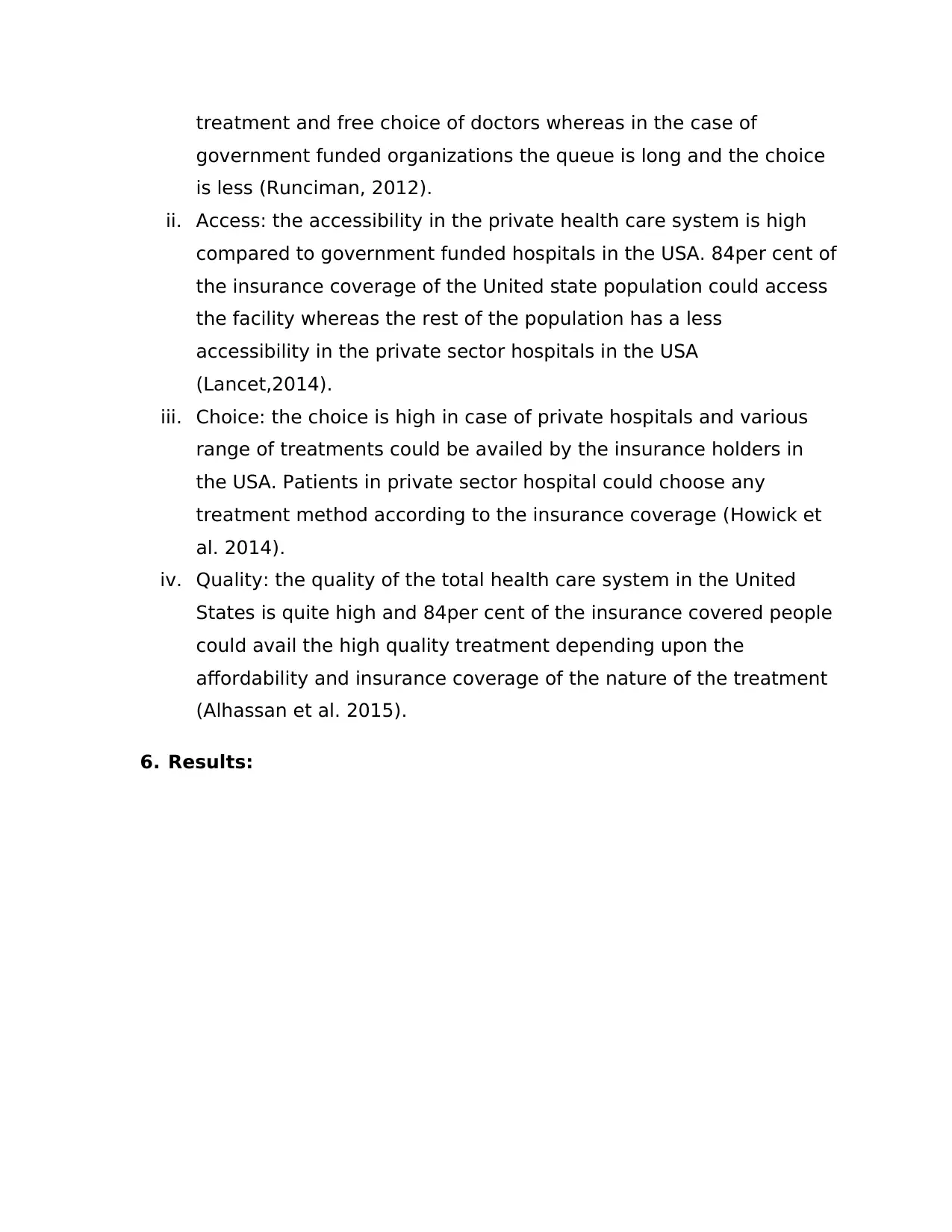
treatment and free choice of doctors whereas in the case of
government funded organizations the queue is long and the choice
is less (Runciman, 2012).
ii. Access: the accessibility in the private health care system is high
compared to government funded hospitals in the USA. 84per cent of
the insurance coverage of the United state population could access
the facility whereas the rest of the population has a less
accessibility in the private sector hospitals in the USA
(Lancet,2014).
iii. Choice: the choice is high in case of private hospitals and various
range of treatments could be availed by the insurance holders in
the USA. Patients in private sector hospital could choose any
treatment method according to the insurance coverage (Howick et
al. 2014).
iv. Quality: the quality of the total health care system in the United
States is quite high and 84per cent of the insurance covered people
could avail the high quality treatment depending upon the
affordability and insurance coverage of the nature of the treatment
(Alhassan et al. 2015).
6. Results:
government funded organizations the queue is long and the choice
is less (Runciman, 2012).
ii. Access: the accessibility in the private health care system is high
compared to government funded hospitals in the USA. 84per cent of
the insurance coverage of the United state population could access
the facility whereas the rest of the population has a less
accessibility in the private sector hospitals in the USA
(Lancet,2014).
iii. Choice: the choice is high in case of private hospitals and various
range of treatments could be availed by the insurance holders in
the USA. Patients in private sector hospital could choose any
treatment method according to the insurance coverage (Howick et
al. 2014).
iv. Quality: the quality of the total health care system in the United
States is quite high and 84per cent of the insurance covered people
could avail the high quality treatment depending upon the
affordability and insurance coverage of the nature of the treatment
(Alhassan et al. 2015).
6. Results:
⊘ This is a preview!⊘
Do you want full access?
Subscribe today to unlock all pages.

Trusted by 1+ million students worldwide

Australian Health System
Hospitals
Primary health care
Other recurrent
Figure 1: Australian Health system
(Source:Corallo et al. 2014)
AUSTRALIA USA BRITAIN
80.4
80.6
80.8
81
81.2
81.4
81.6
81.8
82
82.2
LIFE EXPECTANCY
Figure 2: Life Expectancy among the inhabitant
(Source: Corallo et al. 2014)
Hospitals
Primary health care
Other recurrent
Figure 1: Australian Health system
(Source:Corallo et al. 2014)
AUSTRALIA USA BRITAIN
80.4
80.6
80.8
81
81.2
81.4
81.6
81.8
82
82.2
LIFE EXPECTANCY
Figure 2: Life Expectancy among the inhabitant
(Source: Corallo et al. 2014)
Paraphrase This Document
Need a fresh take? Get an instant paraphrase of this document with our AI Paraphraser
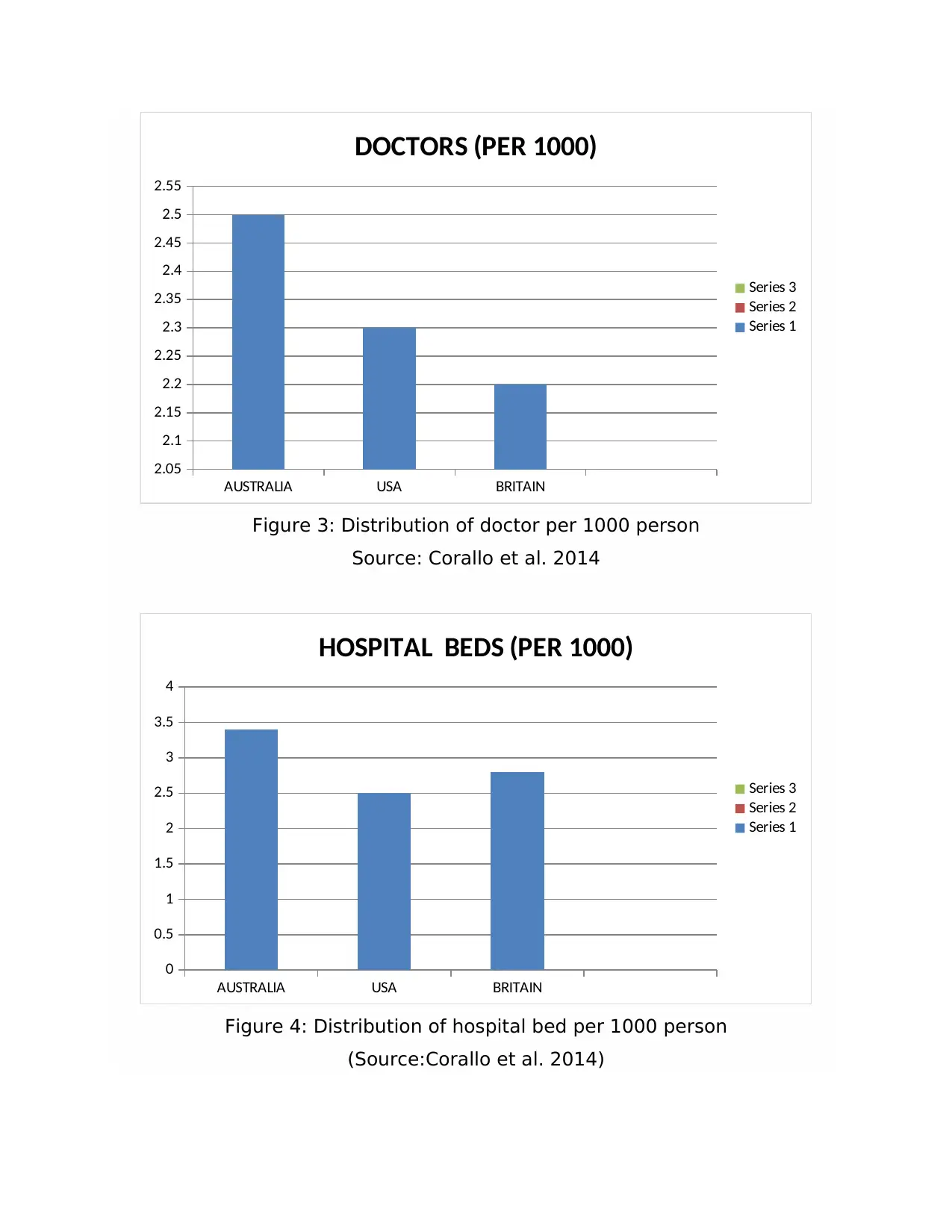
AUSTRALIA USA BRITAIN
2.05
2.1
2.15
2.2
2.25
2.3
2.35
2.4
2.45
2.5
2.55
DOCTORS (PER 1000)
Series 3
Series 2
Series 1
Figure 3: Distribution of doctor per 1000 person
Source: Corallo et al. 2014
AUSTRALIA USA BRITAIN
0
0.5
1
1.5
2
2.5
3
3.5
4
HOSPITAL BEDS (PER 1000)
Series 3
Series 2
Series 1
Figure 4: Distribution of hospital bed per 1000 person
(Source:Corallo et al. 2014)
2.05
2.1
2.15
2.2
2.25
2.3
2.35
2.4
2.45
2.5
2.55
DOCTORS (PER 1000)
Series 3
Series 2
Series 1
Figure 3: Distribution of doctor per 1000 person
Source: Corallo et al. 2014
AUSTRALIA USA BRITAIN
0
0.5
1
1.5
2
2.5
3
3.5
4
HOSPITAL BEDS (PER 1000)
Series 3
Series 2
Series 1
Figure 4: Distribution of hospital bed per 1000 person
(Source:Corallo et al. 2014)

HEALTH CARE
ISSUES
AUSTRALIA USA BRITAIN
Basic concept The health care
system in
Australia is the
mixed type
where the
governmental
control is
accompanied
with the
privatization.
Each and every
Australian
Citizen is
entitled to the
access of the
Universal
Medical Cover
which is also
called
Medicare.
Being an
industrialized
country, the
access to health
care system is
not ensured by
the contextual
government.
However, the
government has
provided
employee
retirement
income security
act which
guarantees full
employer
preference over
health insurance.
Hence, it is seen
that the health
care system in
the United States
majorly owns by
the private
sector.
The Government
of the contextual
country
establishes a
statutory body
named National
Health Service
or NHS to ensure
the health of
their citizen.
Cost (total
health care
4,115 dollar 9,086 dollar 3,364 dollar
ISSUES
AUSTRALIA USA BRITAIN
Basic concept The health care
system in
Australia is the
mixed type
where the
governmental
control is
accompanied
with the
privatization.
Each and every
Australian
Citizen is
entitled to the
access of the
Universal
Medical Cover
which is also
called
Medicare.
Being an
industrialized
country, the
access to health
care system is
not ensured by
the contextual
government.
However, the
government has
provided
employee
retirement
income security
act which
guarantees full
employer
preference over
health insurance.
Hence, it is seen
that the health
care system in
the United States
majorly owns by
the private
sector.
The Government
of the contextual
country
establishes a
statutory body
named National
Health Service
or NHS to ensure
the health of
their citizen.
Cost (total
health care
4,115 dollar 9,086 dollar 3,364 dollar
⊘ This is a preview!⊘
Do you want full access?
Subscribe today to unlock all pages.

Trusted by 1+ million students worldwide

expenditure
per capita)
Accessibility
(per 1000
population)
Doctor: 3.4
Hospital bed:
3.4
Nurse:11.3
Acute care: 3.4
Doctor:2.6
Hospital bed: 2.5
Nurse: 7.9
Acute care: 2.5
Doctor: 2.8
Hospital bed:2.8
Nurse: 8.2
Acute care:2.7
Choices As the
Australian
health care
system is a
mixed system
where
privatization
and
governmental
control coexist,
the choice of
health care is
moderate.
In the case of the
United States,
the choice is
relatively high as
people have sole
responsibility for
the hospital bill
payment.
As the
healthcare
system is fully
controlled by
statutory
organization
National Health
Service or NHS,
the choice is
less.
Quality Moderate
quality
moderate
affordability
High quality low
affordability
Comparatively
Low quality but
high
affordability.
Ranking as per
World Health
Organization
(WHO)
32 37 18
Table 1: Comparisons summarized in charts, tables, pro/con lists etc.
(Source:Corallo et al. 2014)
per capita)
Accessibility
(per 1000
population)
Doctor: 3.4
Hospital bed:
3.4
Nurse:11.3
Acute care: 3.4
Doctor:2.6
Hospital bed: 2.5
Nurse: 7.9
Acute care: 2.5
Doctor: 2.8
Hospital bed:2.8
Nurse: 8.2
Acute care:2.7
Choices As the
Australian
health care
system is a
mixed system
where
privatization
and
governmental
control coexist,
the choice of
health care is
moderate.
In the case of the
United States,
the choice is
relatively high as
people have sole
responsibility for
the hospital bill
payment.
As the
healthcare
system is fully
controlled by
statutory
organization
National Health
Service or NHS,
the choice is
less.
Quality Moderate
quality
moderate
affordability
High quality low
affordability
Comparatively
Low quality but
high
affordability.
Ranking as per
World Health
Organization
(WHO)
32 37 18
Table 1: Comparisons summarized in charts, tables, pro/con lists etc.
(Source:Corallo et al. 2014)
Paraphrase This Document
Need a fresh take? Get an instant paraphrase of this document with our AI Paraphraser

7. Conclusion:
All of these three countries have a lack of doctors as per 1000 patients. It
is also accompanied by the problem of lack of hospital beds per 1000
patients. Hence, the welfare of the patients should be the first priority to
the authority instead of anything else. On this note, each of the above
discussed countries needs to pay more attention to improve their doctor
patients’ ration along with the number of bed allocations.
i. Advantages of Australia's system compared to Britain: More choices
are available as it is a mixed system.
ii. Advantages of Australia's system compared to the USA: It has greater
affordability as it is partially controlled by the governmental body.
iii. Ways of improvement of Australia's system of implementing
elements of the British or US system: Australia’s health care system
will be better if they concentrate on the patient’s problem, more than
their money making thought. Co-payment is something that the poor
cannot enjoy even when they want that facility.
iv. Ways of improvement of the British, US systems: the British
healthcare system needs to pay more attention to the quality,
whereas the US system needs to provide health care at more
affordable rates.
All of these three countries have a lack of doctors as per 1000 patients. It
is also accompanied by the problem of lack of hospital beds per 1000
patients. Hence, the welfare of the patients should be the first priority to
the authority instead of anything else. On this note, each of the above
discussed countries needs to pay more attention to improve their doctor
patients’ ration along with the number of bed allocations.
i. Advantages of Australia's system compared to Britain: More choices
are available as it is a mixed system.
ii. Advantages of Australia's system compared to the USA: It has greater
affordability as it is partially controlled by the governmental body.
iii. Ways of improvement of Australia's system of implementing
elements of the British or US system: Australia’s health care system
will be better if they concentrate on the patient’s problem, more than
their money making thought. Co-payment is something that the poor
cannot enjoy even when they want that facility.
iv. Ways of improvement of the British, US systems: the British
healthcare system needs to pay more attention to the quality,
whereas the US system needs to provide health care at more
affordable rates.
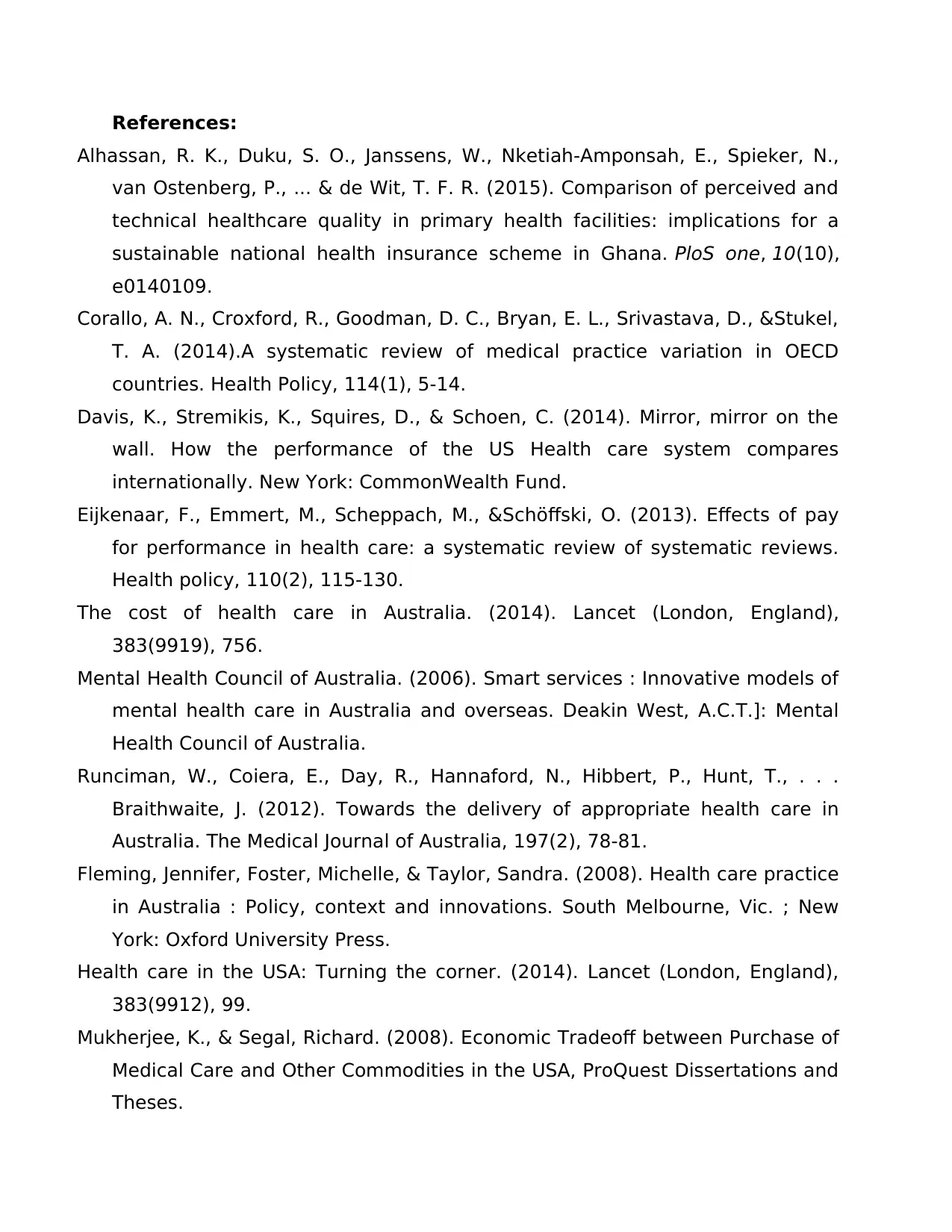
References:
Alhassan, R. K., Duku, S. O., Janssens, W., Nketiah-Amponsah, E., Spieker, N.,
van Ostenberg, P., ... & de Wit, T. F. R. (2015). Comparison of perceived and
technical healthcare quality in primary health facilities: implications for a
sustainable national health insurance scheme in Ghana. PloS one, 10(10),
e0140109.
Corallo, A. N., Croxford, R., Goodman, D. C., Bryan, E. L., Srivastava, D., &Stukel,
T. A. (2014).A systematic review of medical practice variation in OECD
countries. Health Policy, 114(1), 5-14.
Davis, K., Stremikis, K., Squires, D., & Schoen, C. (2014). Mirror, mirror on the
wall. How the performance of the US Health care system compares
internationally. New York: CommonWealth Fund.
Eijkenaar, F., Emmert, M., Scheppach, M., &Schöffski, O. (2013). Effects of pay
for performance in health care: a systematic review of systematic reviews.
Health policy, 110(2), 115-130.
The cost of health care in Australia. (2014). Lancet (London, England),
383(9919), 756.
Mental Health Council of Australia. (2006). Smart services : Innovative models of
mental health care in Australia and overseas. Deakin West, A.C.T.]: Mental
Health Council of Australia.
Runciman, W., Coiera, E., Day, R., Hannaford, N., Hibbert, P., Hunt, T., . . .
Braithwaite, J. (2012). Towards the delivery of appropriate health care in
Australia. The Medical Journal of Australia, 197(2), 78-81.
Fleming, Jennifer, Foster, Michelle, & Taylor, Sandra. (2008). Health care practice
in Australia : Policy, context and innovations. South Melbourne, Vic. ; New
York: Oxford University Press.
Health care in the USA: Turning the corner. (2014). Lancet (London, England),
383(9912), 99.
Mukherjee, K., & Segal, Richard. (2008). Economic Tradeoff between Purchase of
Medical Care and Other Commodities in the USA, ProQuest Dissertations and
Theses.
Alhassan, R. K., Duku, S. O., Janssens, W., Nketiah-Amponsah, E., Spieker, N.,
van Ostenberg, P., ... & de Wit, T. F. R. (2015). Comparison of perceived and
technical healthcare quality in primary health facilities: implications for a
sustainable national health insurance scheme in Ghana. PloS one, 10(10),
e0140109.
Corallo, A. N., Croxford, R., Goodman, D. C., Bryan, E. L., Srivastava, D., &Stukel,
T. A. (2014).A systematic review of medical practice variation in OECD
countries. Health Policy, 114(1), 5-14.
Davis, K., Stremikis, K., Squires, D., & Schoen, C. (2014). Mirror, mirror on the
wall. How the performance of the US Health care system compares
internationally. New York: CommonWealth Fund.
Eijkenaar, F., Emmert, M., Scheppach, M., &Schöffski, O. (2013). Effects of pay
for performance in health care: a systematic review of systematic reviews.
Health policy, 110(2), 115-130.
The cost of health care in Australia. (2014). Lancet (London, England),
383(9919), 756.
Mental Health Council of Australia. (2006). Smart services : Innovative models of
mental health care in Australia and overseas. Deakin West, A.C.T.]: Mental
Health Council of Australia.
Runciman, W., Coiera, E., Day, R., Hannaford, N., Hibbert, P., Hunt, T., . . .
Braithwaite, J. (2012). Towards the delivery of appropriate health care in
Australia. The Medical Journal of Australia, 197(2), 78-81.
Fleming, Jennifer, Foster, Michelle, & Taylor, Sandra. (2008). Health care practice
in Australia : Policy, context and innovations. South Melbourne, Vic. ; New
York: Oxford University Press.
Health care in the USA: Turning the corner. (2014). Lancet (London, England),
383(9912), 99.
Mukherjee, K., & Segal, Richard. (2008). Economic Tradeoff between Purchase of
Medical Care and Other Commodities in the USA, ProQuest Dissertations and
Theses.
⊘ This is a preview!⊘
Do you want full access?
Subscribe today to unlock all pages.

Trusted by 1+ million students worldwide
1 out of 13
Related Documents
Your All-in-One AI-Powered Toolkit for Academic Success.
+13062052269
info@desklib.com
Available 24*7 on WhatsApp / Email
![[object Object]](/_next/static/media/star-bottom.7253800d.svg)
Unlock your academic potential
Copyright © 2020–2025 A2Z Services. All Rights Reserved. Developed and managed by ZUCOL.




